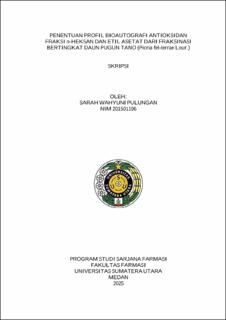| dc.description.abstract | Background: Free radicals are highly reactive molecules that can damage body
cells, proteins and fats. Therefore, the presence of antioxidants is very important to
neutralize free radicals. Antioxidants can be obtained from natural sources, one of
which is pugun tano leaves. Thin layer chromatography (TLC) bioautography test
was conducted to identify active compounds that have activity as antioxidants.
Objective: To determine the n-hexane fraction and ethyl acetate fraction of pugun
tano leaves can counteract DPPH free radicals using TLC bioautography method.
Methods: The research include plant identification, sample collection, sample
processing, extract preparation and fractionation, characterization of simplisia and
extracts, phytochemical screening of simplisia, extracts, and fractions of n-hexane
and ethyl acetate, antioxidant activity test with thin layer chromatogaphy (TLC)
bioautography using 3 types of mobile phases namely chloroform acetone: formic
acid (10:2:1), mixture of chloroform: methanol: water (64:50:10), mixture of ethyl
astetate: methanol: water (8: 1: 1), campuran chloroform: ethyl astetate: n-butanol:
water (5: 2: 2: 1) and mixture of n-hexane: ethyl acetate (8:2).
Results: Characterization of pugun tano leaf simplisia obtained water content
7.98%, water soluble juice content 20.8%, ethanol soluble juice content 9.23%, total
ash content 1.87%, and acid insoluble ash content 0.3%. Characterization of ethanol
extract of pugun tano leaves obtained a moisture content of 9.28%, total ash content
of 0.13%, and acid insoluble ash content of 0.09%. Phytochemical screening of
simplisia and pugun tano leaf extract contains flavonoids, glycosides, saponins,
steroids and tannins, in the n-hexane fraction contains flavonoids and steroids while
in the ethyl acetate fraction contains flavonoids, saponins and steroids. The results
of the antioxidant activity test by TLC bioautography obtained effective stain
separation obtained in the ethyl acetate fraction using the mobile phase chloroform:
acetone: formic acid (10: 2: 1) which is most effective as an antioxidant.
Conclusion: The compound group that has antioxidant activity is the flavonoid
compound group in the ethyl acetate fraction of pugun tano leaves. | en_US |


